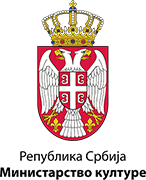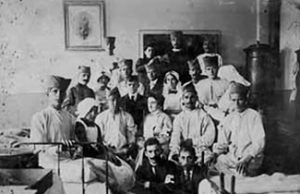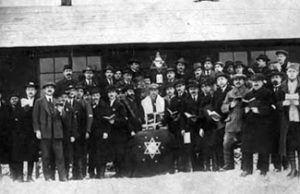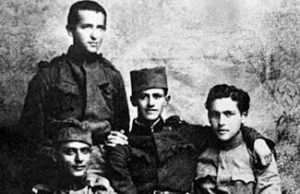With the renewal of political life in Corfu, the conflicts between political parties were also renewed. Nikola Pašić relied on the majority in the National Assembly and full support of the Entente and thus managed to keep control of all decisions and practical moves made. This simplified the manner of managing state politics and ensured continuity under war conditions, but led to monopolising competences and spoiling the political climate. At the same time, there was another conflict, much more severe and subdued. It was a continuation of the conflict between military and civilian authorities which was ongoing in Serbia since the assassination of Aleksandar Obrenović in 1903. The main role in this was played by the secret military officers’ organisation „Crna ruka“ (Black Hand) headed by colonel Dragutin Dimitrijević Apis. He was a great patriot, but with strong political ambitions, and thus a threat to the dynasty and the parliamentary regime. The conflict culminated in Corfu and ended with the arrest of Dimitrijević and nine other highly ranking officers, a number of volunteers and civilians, and the investigation was undertaken against another 124 officers. Under an orchestrated and framed indictment that they had organised the assassination against Prince Regent Aleksandar, the ten indictees were tried before the Military Court in Thessalonica from 2 April to 23 May 1917. Death sentences were pronounced for three indictees, including Dimitrijević, and they were executed on 13 June 1917 in the vicinity of Thessalonica. Thus, Prince Regent Aleksandar, assisted by the Government of Nikola Pašić, came victorious out of this conflict.
The Serbian Government was trying to keep control over the political action for the unification, while the Yugoslav Committee, although funded by the Serbian Government, was trying to be as independent in its role as possible. Between the Serbian Government and the Yugoslav Committee, as well as among the members of the Committee themselves, there were differences regarding the set up of the future state. In order to build consensus regarding the key issues, a meeting was held in Corfu between 15 June and 27 July 1917 of representatives of the Serbian Government, joined by the Speaker of the National Assembly and representatives of the Yugoslav Committee headed by the distinguished Croatian politician Anto Trumbić. In contrast to Serbian representatives, who advocated equality of all religions, Trumbić did not support the equality of Muslims and Jews with Serbian Orthodox and Roman Catholic religion. Yet, the stance of the Serbian Government prevailed and the Corfu Declaration, published on 20 July 1917, stipulated equality of all religions. The Declaration determined that the future country shall be called the Kingdom of Serbs, Croats and Slovenes, that it shall be a constitutional and democratic parliamentary monarchy. According to the Declaration, all three national names are equal, there is equality between the Cyrillic and Latin script, all citizens are equal and have equal rights, the state must reflect religious peace, and there is to be equal and general voting right. The Declaration was welcomed by all supporters of unification. It was also welcomed by the Montenegrin Committee for National unification which on 11 August in Paris made a statement that it fully adopts the Corfu Declaration „convinced that it reflects the aspirations of the Serbian people of Montenegro“.
The Yugoslav movement was getting stronger in AustriaHungary itself. The death of Emperor Franz Joseph in 1916 and the coming to throne of Tsar Karl in 1916, followed by a great amnesty of political prisoners, contributed to the revival of political life and the strengthening of the Yugoslav movement. Deputies from the Yugoslav countries within the Austrian part of the Monarchy established in the Parliament in Vienna a separate caucus. On behalf of the club, on 30 May 1917, Anton Korošec read the Declaration which emphasised that deputies will work towards the unification of all countries within the Monarchy where Slovenes, Croats and Serbs are living into an independent “state entity” which would be „under the auspices of the Habsburg-Lotharing dynasty“. Although a compromise, this document, named the May Declaration, was a great step towards the unification of the Yugoslavs within the Monarchy, and contributed to the disintegration of the Monarchy. The Declaration made a strong impression across the Yugoslav parts of the Monarchy. The signs of the country coming apart were becoming increasingly obvious. Defeats at fronts, deprivation caused by war, the increasing number of soldiers deserting the army – were signs of a profound crisis that was soon to be resolved.
The USA joining the war against Germany on 6 April 1917 and against Austria-Hungary in December the same year had a crucial significance for the unfolding of World War One, as well as for resolving the issue of Yugoslav unification. The huge military and financial assistance to the countries of Entente, along with the arrival of two million US troops to the European war front have turned around the war situation. The Serbian Government was aware of the significance of the US entering the war, and it expected not only assistance in loans and armament, but also in support to the achievement of the Yugoslav programme. Other nations of Central and Eastern Europe equally had hopes for US support to achieving national liberation. Already as of June 1917 financial aid for Serbia started to arrive from the US. In order to win the support of the USA, Nikola Pašić decided to send to the US a mission that would be tasked with informing the American public and authorities about the Yugoslav programme of the Serbian Government. Before the mission was sent, at end of September 1917, Pašić sent to the US the sanitation service captain, Dr David Albala with the task to promote the war goals of Serbia among the American Jews. At the beginning of 1918, the Chief Rabbi of Serbia, Dr Isak Alkalaj, also arrived to the US with the same task as Dr Albala. The Serbian delegation, headed by the Ambassador to Paris Dr Milenko Vesnić, arrived to the US on 20 December 1917, and soon met with the highest state officials, foreign affairs secretary, Lansing, and President Woodrow Wilson. The political objectives of the mission had not been achieved by its return at the beginning of February 1918 as the USA was not yet ready to accept the destruction of Austria-Hungary.
Both captain Albala and the Head Rabbi Alkalaj were very active among the Jewish and general US public. Somewhat before the arrival of Albala, on 2 November 1917, the UK Government by its foreign secretary’s declaration (the Balfour Declaration) supported the creation of the “national home for the Jewish people” in Palestine. At Albala’s initiative, the deputy Vesnić on 27 December 1917, sent him a letter confirming that Serbia accepts the Balfour Declaration. Thereby the government of a small occupied Serbia was the first after the UK Government to support the renewal of the Jewish state in Palestine. This had been done quite explicitly, in contrast with the actual Balfour Declaration, which aroused numerous controversies and doubts. The letter was written in the English language as it was intended to be published. Thanks to Albala, the letter was soon published in all major US newspapers, presenting a picture of Serbia as a tolerant, broadminded, and democratic country, especially among the influential Jewish circles.
The adoption of the Corfu Declaration once again demonstrated to Allied countries that the Yugoslav peoples are united in the effort to create a joint state. The Serbian Government through diplomatic and public action tried to get the support of the Allies to endorse the Yugoslav programme, the biggest obstacle to which was lack of readiness to put an end to the Austria-Hungary. The project of unification of South Slavs was just one among the many national movements by peoples within the Monarchy, because Poles, Checks, Slovaks, Romanians were equally aspiring for the creation of their nation states, and this was impossible without the breaking up of the Monarchy. The Bolshevik revolution in Russia at the beginning of November 1917 provided a strong incentive to this process, by promoting the concept of national self-determination. Building on the democratic principles and the idea of self-determination, The US President Woodrow Wilson at the beginning of January 1918 presented to Congress the “Fourteen Points”, supporting the right of nations to self-determination, restoration of occupied countries, rejection of secret agreements and freedom of navigation upon the seas.
The war at the Western Front, despite heavy losses, was not ensuring a decisive advantage to either side. Yet, the course of the war during 1918 was increasingly demonstrating that the Entente allies were getting closer to victory. This did not change significantly even after the Bolshevik Russia exited the war after brokering a peace treaty with the Central Powers in Brest-Litovsk at the beginning of March 1918. As a result of this peace treaty, the Central powers were given the right to occupy Ukraine and Belarus, whose stocks of food partially refilled the losses due to the blockade imposed by the Allies. Peace in the East enabled Germany to shift all its forces to the West and on 20 March launch a major offensive across the river Somme. Germany made a deep breakthrough and Paris was within reach of its artillery. Despite partial successes along other directions, German forces were stopped by June that year. Although both sides had suffered enormous losses of troops, Germany, in contrast to the Allies, had no way of replenishing them.
The change in the stance of the US and subsequently of other Entente Powers happened in June 1918. Thus, the achievement of the Yugoslav national program entered its decisive stage. Within the Monarchy itself the signs of the country’s disintegration were becoming increasingly obvious. These changes were not only of national nature, but also of social character, under the influence of the Bolshevik revolution in Russia and the general weakness of state authorities. In Bosnia and Herzegovina the attacks of Serbian comits against authorities and their supporters grew in frequency, along with setting on fire of bay residences and estates. The situation was similar in Croatia and Slavonia, where the increasing number of deserters from the front and returnees from Russian detention made up the „Green cadres“, whose members were plundering mostly wealthy estate owners and setting the estates on fire. The first precondition for the achievement of the Yugoslav programme was the victory at the front. Understanding the significance of the Thessalonica front for victory over the Central powers, the Allies starting with June 1918, under the command of Louis Franchet d’Esperey began preparations for a decisive offensive. The proposal of the Serbian Army HQ was accepted to begin the offensive on the Serbian part of the front. The British have long opposed the offensive and only some days ahead of its beginning did they agree to participate in it. The forces on the Thessalonica front were equal; on the other side of 626,000 troops of Bulgaria, Germany and Austria-Hungary there stood 628,000 Allied troops, among which 185,000 French (of which about one half from the colonies); 150,000 Serbian troops (among them 20,000 volunteers); 135,000 Greek troops; 120,000 British; 42,000 Italian and 1,000 Albanian soldiers under Esad Pasha. Allied forces were superior in artillery and aviation, which was further strengthened during the preparations. The Chief of the Serbian Army HQ was Commander Živojin Mišić; the commander of the First Army was general Petar Bojović; the commander of the Second Army was commander Stepa Stepanović. The orders of General d’Esperey stated that after the preparations of the artillery on 14 September, the following day should begin with the infantry attach of the Serbian forces, that the attack by British and Greek troops would commence on 18 September, to be followed by the French attack on 24 September 1918. The orders of the Serbian HQ stated that the speed of the break through is decisive for the success of the overall offensive, that it should be done „without rest, until the maximum limits of human and horse power“.
The Allied forces “hurricane” artillery fire accompanied by aviation operations lasted from 14 to 15 September, followed by infantry attack of the Serbian Second Army. After tireless and bloody battles the Bulgarian front was breached along the line Veternik – Dobro Polje, and the following day Kozjak was taken thus enabling a break through into the Tikveš valley. Four Serbian and one French division participated in the offensive. The attack of British-Greek forces on 18 September was a failure and threatened to stop the whole offensive. The Serbian Army HQ decided to continue the attack during the three days which followed and made a break through into the valley of the Vardar river. The quick advance of the Serbian and allied troops was not stopped despite the great back up from the Western front. Austria-Hungarian HQ sent major backup to Serbia as well. It was all in vein since the Serbian and Allied forces advancing from the south was unstoppable. On 29 September the French calvary took Skopje, and delegates of the Bulgarian Government offered capitulation, which was signed in the night of 29/30 September 1918.
Bulgarian capitulation was a heavy blow to the Central Powers, but they still had significant forces in the Balkan front. The Serbian Army HQ did not want to give the enemy time to take a break and organise its defence, so the advance of the Serbian Army continued at full speed. The Serbian Army was highly motivated, it was fighting on its territory for the liberation of its country and enjoyed the support of the population. Their advance was so quick and so powerful that military reports noted that the French calvary could not keep up with the advances of the Serbian infantry. Not waiting for the Allied forces, the Serbian First Army on 2 October defeated an Austria-Hungarian division near Vranje, and got close to Niš, where there were strong German forces. General d’Esperey ordered the Serbian HQ to stop its advancing, and the HQ did not consent. After that the Army commanded by Petar Bojović, who was in the meantime titled commander, struck a heavy blow to German forces in the Niš operation on 11 October and liberated Niš and Prokuplje. This had a huge impact on the future course of the war, as it cut off communication with Turkey, which capitulated on 30 October 1918. The First Army under commander Bojović continued energetically to make its advance to the north and on 1 November at the head of the Danube division he entered Belgrade which greeted him with enthusiasm. The advance of Serbian and allied forces was significantly supported by the population of occupied Serbia and Montenegro. Under the leadership of comits (chetniks) or spontaneously, the local population of the occupied areas attacked enemy units and often locally liberated parts of the territory before the actual arrival of Serbian and Allied troops. Along the valley of the Ibar river, in Sandžak (Raška) and in Montenegro there was a general uprising even before the arrival of liberators. The Austria-Hungary garrison in Cetinje surrendered on 2 November and the same day the uprising and the comits liberated Nikšić.
The Serbian Army on 3 November 1918 reached the northern and the western borders of the country, and the same day Austria-Hungary signed capitulation. Germany signed the armistice on 11 November 1918, whereby the military operations ended in Europe. The war was to be formally ended at the Peace Conference in Paris and by signing of the Treaty of Versailles on 29 June 1919, stating Germany as the one guilty of the war.
Ahead of the announced capitulation, on 2 November 1918, Nikola Pašić requested the Serbian HQ to take Yugoslav territories within Austria-Hungary. The Army HQ issued an order to take the region of Banat east of Timisoara and Arad, the region of Bačka up to the line Subotica-Baja, as well as provinces of Slavonia with Srem, Croatia, Bosnia and Herzegovina, Dalmatia, Kranjska and Koruška. At the same time, the national councils of Yugoslav provinces were sending their delegates to the Serbian HQ requesting the HQ to take their territories, protect their national interests and maintain peace and order. The greatest risk was threatening the western Yugoslav territories where Italy had claims according to the London agreement of 1915. In the taking of the Slovenian territory a significant role was played by Serbian prisoners of war who prevented the breakthrough of the Italian army towards Ljubljana. At the request of the National Council, the Serbian Army on 14 November entered Zagreb, and the same day the advance of the Italian Army was stopped near Rijeka.
The victorious advance of the Serbian Army and Allied forces created the realistic conditions for the unification of the Yugoslav territories of the Monarchy. The previous government simply collapsed, and the unification movement started establishing its authorities. The Croatian Assembly on 29 October 1918 declared the termination of all state and legal links between Croatia, Slavonia and Dalmatia with the Monarchy and made a decision to join the common State of Slovenes, Croats and Serbs headed by the National Council. The Serbian Government supported the National Council in the belief that it would „contribute to speedy unification of all Serbo-Croats and Slovenes in one free state“. During the second half of November 1918 national assemblies of individual provinces made their relevant decisions on unification with Serbia. The National Council in Zagreb on 25 November made a decision on unification of the State of Slovenes, Croats and Serbs with the Kingdom of Serbia and Montenegro into one state. The very same day the Great National Assembly of Serbs, Bunjevac people and other Slavs of Banat, Bačka and Baranja made a decision in Novi Sad that these provinces secede from Hungary and join the Kingdom of Serbia. The Great National Assembly of Serbian people in Montenegro on 26 November 1918 made a decision that King Nikola and the Petrović dynasty be removed from the Montenegrin throne and that Montenegro be united with Serbia and join the common state of Serbs, Croats and Slovenes. In Bosnia and Herzegovina a great majority of districts at their assemblies decided for unconditional unification with Serbia.
The formal act of creating the Yugoslav state took place in Belgrade on 1 December 1918 in the house of the Krsmanović family at Terazije Square, where the Royal Court was temporarily accommodated. Representatives of the National Council from Zagreb read their Address, and Prince Regent Aleksandar read his Response to the Address, presenting the basic principles regarding the internal organisation of the united state until the time of convening the Constitutional Assembly, to decide the final structure of the state.
In the war for liberation and unification of Yugoslav peoples Serbia endured exceptional losses in population which cannot be replenished. According to official data presented at the Peace Conference in Paris at the beginning of 1919, Serbia lost about one million people during the war, of which 369,518 soldiers and 630,000 civilians. According to other data, the Serbian losses were about 1,200,000 and some sources estimated them at 1,300,000 people. The number of disabled was in hundreds of thousands. Although presently it is estimated that the losses were much lower, it is beyond dispute that they by far exceed the losses of other countries which participated in the Great War. This war, unprecedented by its scope in previous history, took about 17 million lives, among them 7 million civilians, and 20 million wounded.
Serbia at the end of the war was destroyed and plundered. Material devastation was enormous and estimated at 7 to 10 billion golden francs. Into building the united state Serbia invested not only huge human and material losses, but also its statehood and tradition, as well as the efforts to define and provide diplomatic support for the program of Yugoslav unification. Thanks to its military force Serbia preserved the territory in which Yugoslav peoples lived and prevented its segmentation. As one of the states which won the victory, putting under its auspices the other Yugoslav peoples, it made it possible for them to avoid the status of the defeated and join the victorious side with almost no losses.
During World War One Serbian Jews made a significant contribution to liberation and unification, bearing along with other citizens of Serbia the great losses, along the front lines and in the background. Except in battlefield and from sustained wounds and disease, they also perished in Austria-Hungarian camps. The number of Jews living in the pre-war Serbia was between six and seven thousand, of which about 600 took part in the war. Several hundreds were wounded, almost 150 killed, hundreds disabled. Many among them were decorated for the courage they demonstrated. Jewish courage and persecution in the fight for liberation strengthened their position and integration and reputation among the Serbs and this is evidenced by the monument at the entry to the Jewish (Sephardic) cemetery in Belgrade. Jews shared a strong national and patriotic feeling with other citizens of Serbia. The ideals of the youth of that time, the youth to which she herself belonged, were described by Paulina Lebl-Albala as follows: “We were aware that our generation had the honour and the duty to live up to the Kosovo legacy”. When the Serbian Army was entering Belgrade on 1 November 1918 the liberators were welcomed at the Terazije Square by members of the Committee of Belgrade Ladies and with the signing of the Belgrade and Serbian-Jewish Singing Society, who handed colonel Milojević a silver cup. At the welcoming ceremony for the Prince Regent Aleksandar five days later the Serbian national anthem was sung by the Singing Society Stanković and the Serbian-Jewish Singing Society.
Milan Koljanin




